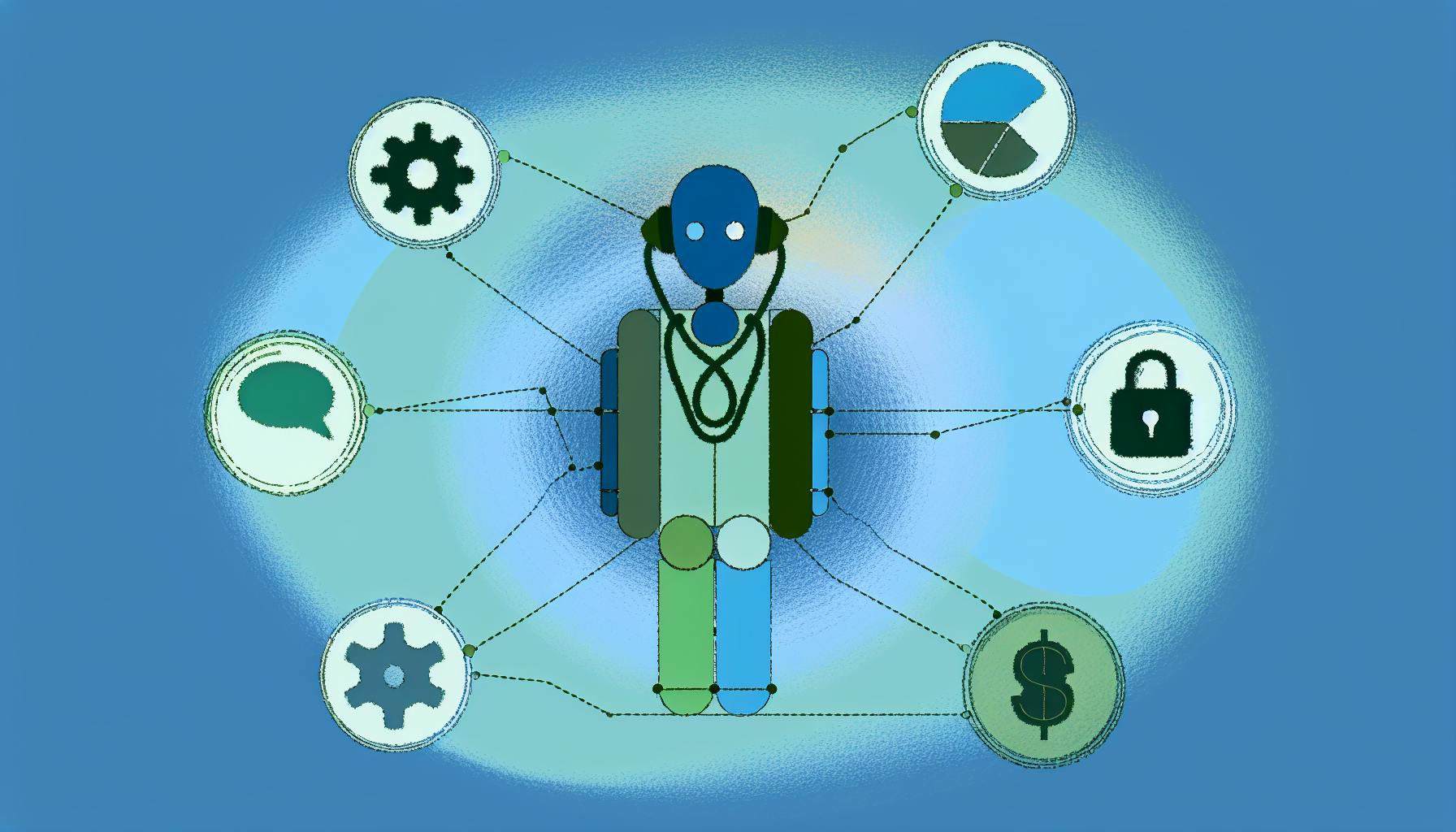AI scribe technology revolutionizes order entry and management in healthcare by automating routine tasks like data entry and note generation. This enables clinicians to focus on patient care, enhancing efficiency and productivity.
Key Benefits of AI Scribes:
- Improve accuracy and reduce errors in order entries
- Streamline order management processes
- Minimize manual documentation tasks
- Facilitate team collaboration with real-time data updates
- Increase productivity by freeing up clinicians' time
- Enhance patient care and satisfaction
- Drive cost savings through optimized resource allocation
By integrating AI scribes into clinical workflows, healthcare providers can unlock significant improvements in operational efficiency, patient outcomes, and overall healthcare experiences.
Issues with Manual Order Handling
Manual order handling can be a slow and error-prone process that hinders clinical workflow efficiency. Many hospitals still rely on paper faxes, copies, and phone calls to manage physician orders. This approach can lead to several issues:
| Issue | Consequence |
|---|---|
| Lost or miscommunicated orders | Compromised patient care and safety |
| Delays in order fulfillment | Prolonged patient wait times and decreased satisfaction |
| Inadequate communication | Poor communication among healthcare teams, leading to misunderstandings and errors |
| Physician burnout | Administrative burden takes time away from critical patient care activities |
The consequences of manual order handling can be far-reaching, affecting not only patient care but also physician satisfaction and overall healthcare outcomes. It is essential to explore more efficient and accurate solutions, such as AI scribe technology, to optimize order management and improve clinical workflow efficiency.
AI Scribes for Workflow Efficiency
The introduction of AI scribes has transformed clinical documentation and order management, leading to significant improvements in workflow efficiency. These digital assistants automate routine tasks, reducing administrative burdens and freeing up healthcare professionals to focus on critical patient care activities.
Time-Saving Benefits
By automating documentation tasks, AI scribes can:
- Reduce the time spent on manual documentation
- Allow healthcare providers to allocate more time to patient care
- Improve patient satisfaction and reduce wait times
Accurate and Complete Clinical Notes
AI scribes can also improve the accuracy and completeness of clinical notes, reducing errors and ensuring that all relevant information is captured.
Efficient Order Management
The integration of AI scribes with electronic health records (EHRs) has improved the efficiency of order management. AI-powered systems can:
| Feature | Benefit |
|---|---|
| Automatic order generation | Reduces errors and delays |
| Real-time tracking and notification | Enables quick response to changing patient needs |
Overall, the implementation of AI scribes has led to significant improvements in workflow efficiency, patient care, and overall healthcare outcomes.
Real-World AI Scribe Implementation
The successful integration of AI scribe software has been observed in various healthcare facilities, leading to significant improvements in clinical workflow efficiency and patient care. One such example is a large healthcare system that integrated AI scribes into their emergency department (ED) workflow.
Integration Process
The healthcare system partnered with an AI scribe vendor to implement the technology in their ED. The integration process involved:
- Training the AI model on the facility's specific documentation requirements
- Integrating the system with their electronic health record (EHR) system
- Designing the AI scribe to capture patient-provider conversations and generate accurate clinical notes in real-time
Challenges Faced
During the implementation process, the healthcare system faced several challenges, including:
| Challenge | Description |
|---|---|
| Ensuring accuracy and completeness of clinical notes | Verifying the AI scribe's ability to generate accurate and complete clinical notes |
| Integrating with existing EHR system | Ensuring seamless integration with the healthcare system's EHR system |
| Training ED staff | Educating ED staff on the use of the AI scribe technology |
Solutions Applied
To address these challenges, the healthcare system:
- Conducted thorough testing and validation of the AI scribe's accuracy and completeness
- Collaborated closely with the AI scribe vendor to ensure seamless integration with their EHR system
- Provided comprehensive training to ED staff on the use of the AI scribe technology
Measurable Outcomes
Following the implementation of the AI scribe technology, the healthcare system observed significant improvements in clinical workflow efficiency and patient care, including:
| Outcome | Result |
|---|---|
| Reduced documentation time | 30% reduction in documentation time, allowing ED staff to focus more on patient care |
| Improved accuracy | AI scribe's accuracy rate above 95%, reducing errors and improving the quality of clinical notes |
| Enhanced patient satisfaction | Patients reported higher satisfaction rates due to increased face-time with ED staff and reduced wait times |
The successful implementation of AI scribe technology in this healthcare system demonstrates the potential of AI to improve clinical workflow efficiency, accuracy, and patient care.
sbb-itb-527d68c
AI Scribe Features for Order Entry
Device Access and Mobility
AI scribes allow healthcare professionals to access patient data and manage orders from anywhere, at any time, using their preferred device. This feature enables providers to stay updated on patient status, make informed decisions, and respond promptly to changing circumstances.
For instance, a physician can use an AI scribe on their mobile device to:
- Access a patient's medical history
- Review test results
- Update medication orders
Workflow Integration and Time Savings
AI scribes integrate seamlessly into existing healthcare workflows, expediting order entry and management processes. By automating routine tasks, AI scribes free up healthcare professionals to focus on more critical tasks.
| Task | Time Savings |
|---|---|
| Data entry | Reduces manual data entry time |
| Transcription | Eliminates manual transcription tasks |
| Order management | Streamlines order management processes |
Reduced Manual Documentation
AI scribes minimize manual documentation tasks, reducing the administrative burden on healthcare professionals.
| Task | Benefit |
|---|---|
| Clinical notes | Generates accurate and complete clinical notes in real-time |
| Data entry | Eliminates manual data entry tasks |
| Order management | Automates order management processes |
Improved Team Collaboration
AI scribes ensure data accessibility and enable teamwork through synchronous data updates across multiple platforms.
| Feature | Benefit |
|---|---|
| Real-time updates | Ensures all healthcare professionals have access to the same accurate and up-to-date information |
| Data accessibility | Enables healthcare teams to work together more effectively |
| Collaboration | Facilitates informed decision-making and prompt responses to changing circumstances |
Benefits of AI Scribes
Improved Accuracy and Error Reduction
The use of AI scribes in healthcare has significantly reduced errors and discrepancies in order entries. This leads to fewer revisions and enhanced patient safety. With AI scribes, healthcare providers can focus on providing high-quality patient care, rather than spending hours correcting errors.
Increased Productivity
AI scribes automate routine tasks and streamline complex processes, freeing up healthcare professionals to focus on more critical tasks. This redirection of time and energy leads to increased productivity and better patient care.
Better Patient Care
By automating routine tasks, AI scribes enable healthcare providers to spend more time on direct patient interaction and individualized care. This leads to better patient outcomes, increased patient satisfaction, and improved overall healthcare experiences.
Cost Savings
The adoption of AI scribes in healthcare leads to significant cost savings in the long run. By automating routine tasks and streamlining complex processes, healthcare providers can reduce administrative overhead, minimize errors, and optimize resource allocation.
| Benefit | Description |
|---|---|
| Improved Accuracy | Reduced errors and discrepancies in order entries |
| Increased Productivity | Automation of routine tasks and streamlining of complex processes |
| Better Patient Care | More time for direct patient interaction and individualized care |
| Cost Savings | Reduced administrative overhead, minimized errors, and optimized resource allocation |
The Future of AI Scribes in Healthcare
The integration of AI scribes in healthcare has transformed the way medical documentation is conducted. With their ability to automate routine tasks, enhance patient care, and drive operational efficiencies, AI scribes have already demonstrated their capacity to optimize healthcare workflows.
The Role of AI Scribes in Shaping the Future of Healthcare
As the healthcare industry continues to evolve, AI scribes will become an indispensable tool for healthcare providers. By processing and analyzing vast amounts of medical data, AI scribes will enable healthcare professionals to make more informed decisions, improve patient outcomes, and drive positive change in the healthcare sector.
The Collaborative Relationship Between AI and Human Medical Scribes
The collaborative relationship between AI and human medical scribes will play a crucial role in shaping the future of healthcare documentation. By leveraging the power of AI, healthcare providers can unlock the full potential of medical scribing, driving innovation and transformation in the healthcare industry.
Embracing AI Scribe Technology
Embracing AI scribe technology is essential for healthcare institutions seeking to improve clinical outcomes, reduce costs, and enhance patient care. By adopting AI scribe technology, healthcare providers can:
| Benefit | Description |
|---|---|
| Improve Clinical Outcomes | Enhance patient care and reduce errors |
| Reduce Costs | Minimize administrative overhead and optimize resource allocation |
| Enhance Patient Care | Increase face-time with patients and provide more personalized care |
By leveraging the power of AI, healthcare providers can unlock the full potential of medical scribing, driving innovation and transformation in the healthcare industry.


